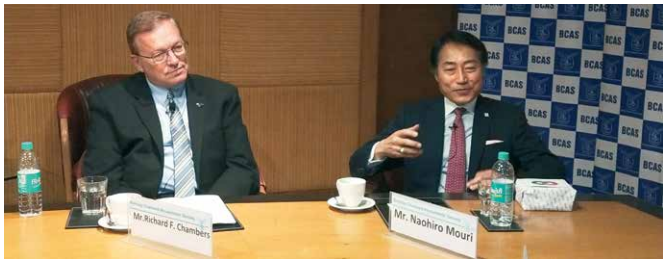Section 14A – When an assessee, a
partnership firm, earns tax free income and disallowance u/s. 14A (r.w. Rule
8D) is to be computed then interest paid, towards the use of partner’s capital,
by the assessee to the partners is not amenable to section 14A in the hands of
partnership firm.
FACTS
The assessee, a partnership firm, engaged in
the business of manufacturing of chemicals etc., had during the relevant
assessment year earned tax free dividend income from investment in mutual funds
which was claimed as exempt income u/s. 10(35) of the Act.
The AO next observed that investment in
mutual funds was made out of interest bearing funds which included interest
bearing partner’s capital also.
The interest so paid to the partners was
claimed as deduction by the assessee against taxable income.
The AO was thus of the view that assessee
had incurred interest expenses which were attributable to earning aforesaid tax
free dividend income. Thus, he invoked provisions of section 14A of the Act
r.w. Rule 8D and proceeded to disallow estimated interest expenditure incurred
in relation to dividend income so earned.
It was the assessee’s contention that while
computing disallowance u/s.14A, disallowance of proportionate interest
attributable to interest bearing partners’ capital is not permissible. It was
submitted that section 14A covers amount in the nature of ‘expenditure’ and not
all statutory allowances and that interest on partner’s capital is not an
‘expenditure’ per se but is in the nature of a deduction u/s. 40(b) just
as depreciation on business capital asset is an allowance and not expenditure.
The AO, however, discarded the various pleas
of the assessee.
The CIT(A) took
note of the contents of the Balance Sheet of the assessee firm for relevant
assessment year and noted that main source of investment in mutual funds have
come from partner’s capital. The partners had introduced capital in the
partnership firm which bears interest @12% per annum. This being so, the
provisions of section 14A are attracted and expenses incurred in relation to
income which does not form part of total income requires to be disallowed.
He accordingly confirmed the action of the
AO and his working of disallowance under Rule 8D.
Aggrieved by the order of the CIT(A), the
assessee filed appeal before the Tribunal.
HELD
The predominant question that arises is
whether, for the purposes of section 14A of the Act, payment of interest to the
partners by the partnership firm towards use of partner’s capital is in the
nature of ‘expenditure’ or not and consequently, whether interest on partners capital is amenable to
section 14A or not in the hands of partnership firm.
In order to adjudicate this legal issue, we
need to appreciate the nuances of the scheme of the taxation. We note that
prior to amendment of taxation laws from AY 1993-94, the interest charged on
partners capital was not allowed in the hands of partnership firm while it was
simultaneously taxable in the hands of respective partners. An amendment was inter
alia brought in by the Finance Act 1992 in section 40(b) to enable the firm
to claim deduction of interest outgo payable to partners on their respective
capital subject to some upper limits.
Hence, as per the present scheme of
taxation, partnership firms complying with the statutory requirements and
assessed as such are allowed deduction in respect of interest to partners
subject to the limits and conditions specified in section 40(b) of the Act. In
turn, these items will be taxed in the hands of the partners as business income
u/s. 28(v).
Share of partners in the income of the firm
is exempt from tax u/s. 10(2A). Thus, the share of income from firm is on a
different footing than the interest income which is taxable under the business
income.
The section
28(v) treats the passive income accrued by way of interest as also salary
received by a partner of the firm as a ‘business receipt’ unlike different
treatments given to similar receipts in the hands of entities other than
partners. In this context, we also note that under proviso to section
28(v), the disallowance of such interest is only in reference to section 40(b)
and not section 36 or section 37. Notably, there has been no amendment in the
general law provided under Partnership Act 1932. The amendment to section 40(b)
as referred hereinabove has only altered the mode of taxation. Needless to say,
the Partnership firm is not a separate legal entity under the Partnership Act.
It is not within the purview of the Income-tax Act to change or alter the basic
law governing partnership. Interest or salary paid to partners remains
distribution of business income.
Section 4 of the Indian Partnership Act 1932
defines the terms partnership, partner, firm and firm name as under :
“Partnership” is the relation
between persons, who have agreed to share the profits of a business, carried on
by all or any of the partners acting for all. Persons who have entered into
partnership with one another are called individually ‘Partners’ and
collectively a ‘firm’ and the name under which their business is carried on is
called the ‘firm name.”
Thus, it is clear that firm and partners of
the firm are not separate person under Partnership Act although they are
separate unit of assessment for tax purposes.
It is relevant here to refer to decision in
the case of CIT vs. R.M. Chidambaram Pillai (1977-106 ITR 292) wherein
Hon’ble Supreme Court has held that:
“A firm
is not a legal person, even though it has some attributes of personality. In
Income-tax law, a firm is a unit of assessment, by special provisions, but it
is not a full person. Since a contract of employment requires two distinct
persons, viz., the employer and the employee, there cannot be a contract of
service, in strict law, between a firm and one of its partners. Payment of
salary to a partner represents a special share of the profits. Salary paid to a
partner retains the same character of the income of the firm. Accordingly, the
salary paid to a partner by a firm which grows and sells tea, is exempt from
tax, under rule 24 of the Indian Income-tax Rules, 1922, to the extent of 60
per cent thereof, representing agricultural income and is liable to tax only to
the extent of 40 per cent.”
The Hon’ble
Supreme Court has also held in the case of CIT vs. Ramniklal Kothari (1969
-74 ITR 57) that the business of the firm is business of the partners of
the firm and, hence, salary, interest and profits received by the partner from
the firm is business income and, therefore, expenses incurred by the partners
for the purpose of earning this income from the firm are admissible as
deduction from such share income from the firm in which he is partner.
Thus, the ‘partnership firm’ and partners
have been collectively seen and the distinction between the two has been
blurred in the judicial precedents even for taxation purposes.
Therefore, the relationship between partner
and firm cannot be inferred as that of lender of funds (capital) and borrower
of capital from the partners, and hence, section 36(1)(iii) is not applicable
at all. Section 40(b) is the only section governing deduction towards interest
to partners. To put it differently, in view of section 40(b) of the Act, the
Assessing Officer purportedly has no jurisdiction to apply the test laid down
u/s. 36 of the Act to find out whether the capital was borrowed for the
purposes of business or not.
As per the
scheme of the Act, the interest paid by the firm and claimed as deduction is
simultaneously susceptible to tax in the hands of its respective partners. The
interest paid to partners and simultaneously getting subjected to tax in the
hands of its partners is merely in the nature of contra items in the hands of
the firms and partners. Consequently interest paid to its partners cannot be
treated at par with the other interest payable to outside parties. Thus, in
substance, the revenue is not adversely affected at all by the claim of
interest on capital employed with the firm by the partnership firm and partners
put together. Thus, capital diverted in the mutual funds to generate alleged
tax free income does not lead to any loss in revenue by this action of the
assessee. In view of the inherent mutuality, when the partnership firm and its
partners are seen holistically and in a combined manner with costs towards
interest eliminated in contra, the investment in mutual funds generating tax free income bears the characteristic of and attributable to its own capital
where no disallowance u/s. 14A read with Rule 8D is warranted. Consequently,
the plea of the assessee is merited in so far as interest attributable to partners.
However, the interest payable to parties other than partners, would be
subjected to provisions of Rule 8D.









